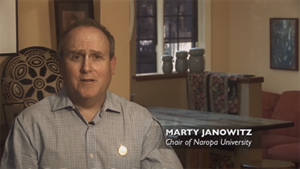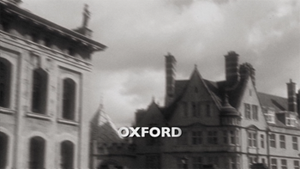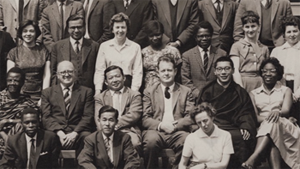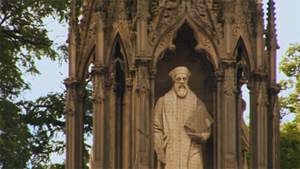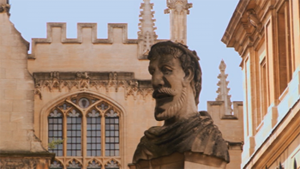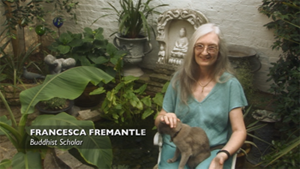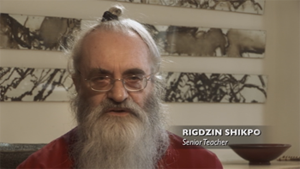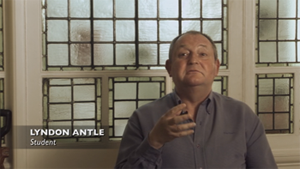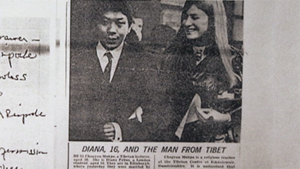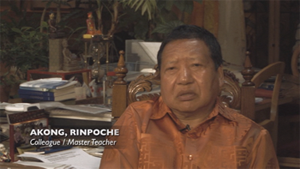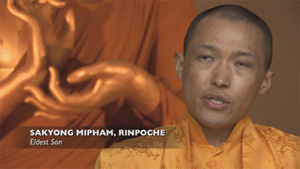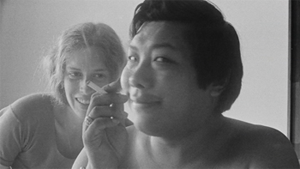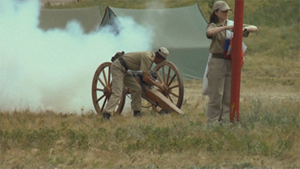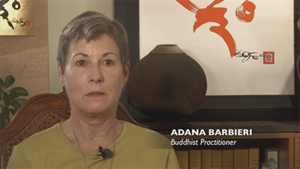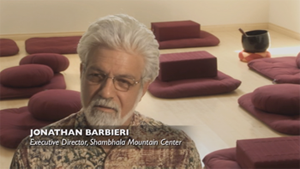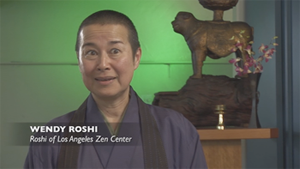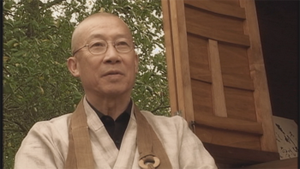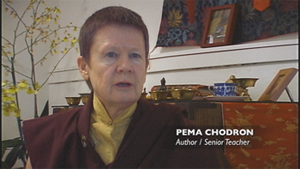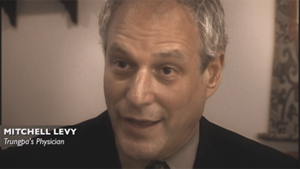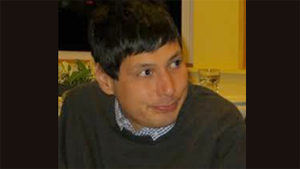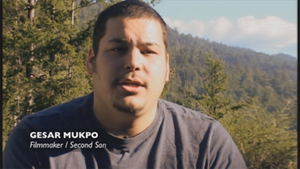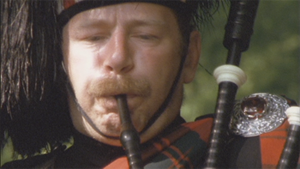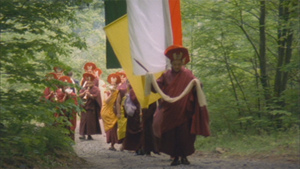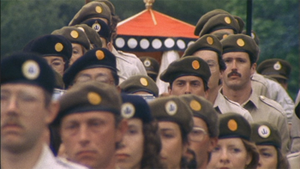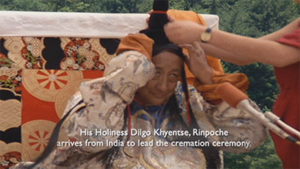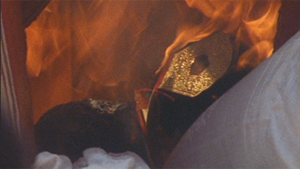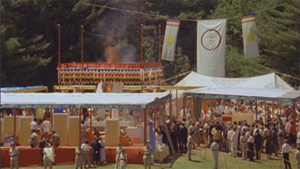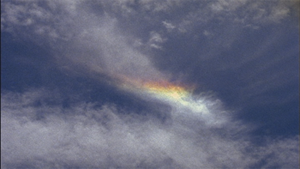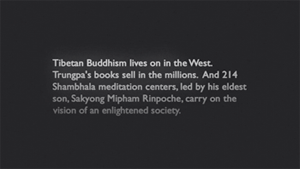by Charles Carreon, Attorney at law [1]
May 17, 2019
NOTICE: THIS WORK MAY BE PROTECTED BY COPYRIGHT
YOU ARE REQUIRED TO READ THE COPYRIGHT NOTICE AT THIS LINK BEFORE YOU READ THE FOLLOWING WORK, THAT IS AVAILABLE SOLELY FOR PRIVATE STUDY, SCHOLARSHIP OR RESEARCH PURSUANT TO 17 U.S.C. SECTION 107 AND 108. IN THE EVENT THAT THE LIBRARY DETERMINES THAT UNLAWFUL COPYING OF THIS WORK HAS OCCURRED, THE LIBRARY HAS THE RIGHT TO BLOCK THE I.P. ADDRESS AT WHICH THE UNLAWFUL COPYING APPEARED TO HAVE OCCURRED. THANK YOU FOR RESPECTING THE RIGHTS OF COPYRIGHT OWNERS.
The Practice of Communion Mediated by a Pharmacological Agent
An Internet search for “Ayahuasca church” reveals that psychedelic religion is booming in popularity in the United States. Ayahuasca practice is not the only form of psychedelic religion, however. For purposes of this article, I define “psychedelic religion” as any religion that uses a sacrament that is pharmacologically active. Sacraments are found in many religions – the bread and wine of Christian ceremony provides a familiar primary example, and Tibetan Buddhists will be familiar with “dutsei”– blessing pills prepared according to ancient recipes, and “amrita” -- saffron-water that is sprinkled and drunk during “empowerments” and “mandala feasts”.
Sacraments that are not pharmacologically active are deemed spiritually efficacious due to the magic of doctrine and the power of priestly incantations, gestures, and lineage authority. For example, the Catholic mass, i.e., the “celebration of the Holy Eucharist” is a ceremony wherein bread and wine are “transubstantiated” by a male priest who communes with the Father Deity, transforming these earthly foods into spiritual nutrition -- the “Body and Blood of Christ.” This is no mere attempt to push believers into contemplation or a sense of deeper connection. Catholic doctrine makes it clear that this communion ceremony is not a “symbolic experience,” but rather the core of the true Christian mysterium tremendum. [ i] As an instructive website for Catholics preparing to receive their First Communion explains, communion “is a mystical and spiritual union of the soul with Jesus … produced in the soul by our physical contact with the sacred Body of Jesus.” [ii] Notwithstanding the doctrinal assertion that “something happens” when believers consume the Eucharist, however, there is no doubt that the faith-inspired imagination of the practitioner must be engaged for the “spiritual union with the soul of Jesus” to occur.
Psychedelic substances are not placebos – they alter the consciousness of those who ingest them. The difference between sacred and profane use of psychedelics is based on the religious application of what Dr. Timothy Leary introduced as the teaching on “set and setting,” in which “set” refers to the “mindset” of the person taking the psychedelic, and “setting” refers to the physical and social environment where the psychedelic is consumed. The law of psychedelic religion in the United States has silently absorbed this teaching by declaring that, when a person ingests a psychedelic with a religious mindset in a religious setting, they are engaging in a “non-drug use” of the substance, [iii] and thus qualify for an exemption from laws that make taking the psychedelic illegal for those who take the substance for any other purpose.
Legal reasoning operates by analogy – like things receive similar treatment. The churches that have prevailed in court on their claims for religious exemption from laws proscribing the possession and manufacture of psychedelic drugs have won because they analogized their activities to those of established Christian religions. A clear analysis of modern US law legitimizing the practice of psychedelic religion makes it clear that, by describing the Native American Church’s practice of eating peyote and the UDV’s practice of drinking Ayahuasca as “sacramental,” the United States Supreme Court has equated eating peyote and drinking Ayahuasca with the Catholic ceremony of communion. [iv] Although we can engage in lengthy discussions of how courts define psychedelic religion, I believe that equating peyote and Ayahuasca with the Christian bread and wine is the key to understanding and developing the jurisprudence of psychedelic religion. Why? Not because the courts like Christian churches and those that claim some Christian elements in their doctrine receive favored treatment. Because without the sacrament of the Holy Eucharist there is no Catholic Mass, and unless a psychedelic substance is essential to the religious experience of a church’s congregants, the church cannot claim First Amendment exemption from federal laws that criminalize the possession and distribution of the substance.
To prevail in a lawsuit claiming the right to an exemption from the Controlled Substance Act (the “CSA”) on grounds of religion, the church must show that the CSA “substantially burdens” the church’s members in ways that go beyond “diminished spiritual fulfillment.” [v] There is only one way to establish this degree of centrality to religious purpose in a jurisprudence where the Christian ceremony of communion prevails as the sine qua non of ritual practice – by drawing the analogy between the use of a psychedelic sacrament and the Holy Eucharist explicitly and unequivocally in all contexts. Hence my definition of psychedelic religion as those that use a pharmacological agent to mediate an experience in which church members engage in communion with the Divine.
Many logical conclusions follow from this conclusion that psychedelic religions seeking lawful exemption from the application of the CSA should define their ceremonies as the sacrament of communion, and I intend to explore them in future articles; however, for the present, I have accomplished what I need to for purposes of this article – to define psychedelic religion based on the centrality of the psychedelic experience itself, an experience without which the religion itself would have no meaning and church members would have no religious practice.
The Consequences of Regulated Status for a Psychedelic Religion
Since 2006, when the UDV won an exemption from the CSA to import and distribute Ayahuasca to its members, [vi] many psychedelic churches have wondered whether they could reach this level of legality. The only known avenue to obtaining such an exemption, aside from a federal lawsuit under the Religious Freedom Restoration Act (“RFRA”), [vii] is to submit an application for exemption to the Drug Enforcement Administration (“DEA”) in compliance with a two-page instruction sheet prepared by the DEA, entitled the Guidance Regarding Petitions for Religious Exemption from the Controlled Substances Act Pursuant to the Religious Freedom Restoration Act (the “Guidance”). [viii] I have discussed the hazards of submitting a Petition for Religious Exemption from the CSA (a "PRE") in compliance with the Guidance, placing particular emphasis on the potential for self-incrimination that is involved in a process that essentially involves delivering a confession of facially criminal conduct to the DEA in hopes that the agency will find that religious motives justify the crime. [ix]
Despite the fact that the DEA has not granted any RFEs, and that the only Ayahuasca church with an PRE currently pending did so only in response to a mildly threatening letter from the DEA, for purposes of this article, we assume that a hypothetical psychedelic church did in fact successfully navigate the PRE process under the Guidance, and received its exemption from the CSA to import, manufacture and distribute its sacrament. Let’s call our hypothetical church the Church of the Ancestral Dreamtime (the “CAD”), whose members call themselves “Tabernanths” because, in a suitably sacred set and setting, they consume an extract of Iboga Tabernanthe, and receive sacred communications from the Ancestral Dreamtime in a state of ecstatic communion. Suffice it to say that without Iboga, there would be no CAD, because there is no way to reach the Ancestral Dreamtime except by consuming Iboga in CAD ceremony, that includes the performance of ceremonial dance and chanting to establish proper set and setting.
After celebrating their success, what will the legal consequences of regulation be for the CAD? In a word, a lot of paperwork. A scholarly article on the UDV’s experience operating a psychedelic church under the aegis of DEA regulation recites: [x]
“Despite the UDV’s victory in the Supreme Court, during ensuing years the US Government complicated the group’s activities through a series of bureaucratic and administrative strategies. Because of the legal path that this dispute followed, the UDV was still subject to a variety of pressures and uncertainties, and the agreement finally settled this dispute between them. The agreement *** establishes that the UDV must: inform the DEA of all shipments of hoasca in advance, as well as quantities; follow a strict bureaucratic protocol to import, store and distribute hoasca; keep a record of how many participants attend each session and the total amount of hoasca consumed in each session; keep hoasca in rooms protected with a solidcore door and a deadbolt lock to avoid thefts and diversion; inform the DEA of the names of people authorized to keep the hoasca, and allow the DEA to investigate whether this person has been previously convicted of a felony relating to controlled substances.”
This list is actually only the beginning of the recordkeeping responsibilities that the UDV assumed in its settlement with the DEA, but it is sufficient to provide the context necessary to continue our discussion. As the author of the quoted article notes by citing several examples, the settlement has affected how the UDV conducts its practices, altering its character in significant ways. Thus, the UDV has changed from a religion with rustic origins in the Amazonian rainforest, that transmitted liturgical lore through an oral tradition, utilized a wide range of herbs in addition to Ayahuasca, and entrusted its members with adequate quantities of Ayahuasca to engage in self-initiated psychedelic practice outside of formal church meetings, into a religion that has large urban memberships, relies extensively on written records, audio-recordings and commercial music, has largely eliminated the use of all substances other than Ayahuasca in its ceremonies, and does not allow practitioners to take Ayahuasca home for personal use. Further, it has initiated a recordkeeping regime that is an open book to the DEA, abrogating the rights of privacy that have traditionally been accorded to UDV members in its home country of Brazil. [xi]
The Required Records Doctrine
It will not surprise you to learn that our modern regulatory state has a powerful judicial hammer behind it to compel the disclosure of information that is needed to maintain the regulatory system. This judicial hammer is known as the Required Records Doctrine, and it dates back to 1948, when the federal government was actively engaged in what today might be reviled as socialism – regulating the prices of fruits and vegetables:
“The petitioner, a wholesaler of fruit and produce, on September 29, 1944, was served with a subpoena duces tecum and ad testificandum, issued by the Price Administrator under authority of the Emergency Price Control Act. The subpoena directed petitioner to appear before designated enforcement attorneys of the Office of Price Administration and to produce ‘all duplicate sales invoices, sales books, ledgers, inventory records, contracts and records relating to the sale of all commodities from September 1, 1944 to September 28, 1944.’" [xii]
The greengrocer produced all of the records, and made a feeble objection under the Fifth Amendment that the Supreme Court brushed aside with nary a comment. The records, the Court held, had to be produced because Congress had enacted a wartime law to regulate the sales of fruits and vegetables, and requiring greengrocers to keep the very records that had been subpoenaed. There was nothing unconstitutional about it, because such regulatory documents essentially became “public records,” and the government had the right to inspect them upon demand.
The Required Records Doctrine is still the law of the land, and will still nullify any Fifth Amendment objection. It has often been used to compel production of tax returns and documents that would disclose violations of the tax laws. Recently, it was used by the Ninth Circuit to compel the disclosure of banking records to a Grand Jury over a Fifth Amendment objection that producing them would incriminate the witness for tax evasion and banking crimes. [xiii] Although the witness objected that banking records were protected by privacy regulations, the Ninth Circuit tortured the meaning of public records with the ready implement of prior precedent, holding that based on a case involving the compelled disclosure of confidential medical records, any document, however personal and private, can have "’public aspects’ for purposes of the Required Records Doctrine and that ‘expectations of privacy do not negate a finding that there is a public aspect to the files under the ... regulatory schemes….’" [xiv]
Most importantly for our purposes, the court rejected a claim that even if the documents had to be kept in order to engage in offshore banking, they were still protected from disclosure under the Fifth Amendment because particular matters recorded in them tended to incriminate the witness. To that contention, the Ninth Circuit’s response was simple: “[N]o one is required to participate in the activity of offshore banking….” [xv] This principle is most important for any psychedelic church that is considering submitting a request for exemption to the DEA, because if the church gets what it’s asking for, it will simply enter into a regulated relationship with the DEA, and it will be required to produce all the records that the DEA requires it to keep, upon demand. Should the church object, under the Fifth Amendment or on any grounds, the answer will simply be: “No one is required to operate a psychedelic church.”
A Brief Discussion of the First Amendment Establishment and Free Exercise Clauses
The First Amendment of the United States Constitution provides the bedrock of protections for religious freedom in the United States, and the sole protection for freedom to practice psychedelic religion. The courts divide the First Amendment’s provisions regarding religious into two clauses: first, the Establishment Clause -- “Congress shall make no law respecting an establishment of religion” -- and second, the Free Exercise Clause -- “or prohibiting the free exercise thereof....” RFRA is merely a Congressionally-created remedy for an excess of judicial activism that had wiped away decades of Free Exercise jurisprudence, and reinstated the rule pursuant to which the courts had fashioned various religious exemptions to laws of general application, on the grounds that the government was forbidden from punishing people for living according to sincerely-held religious beliefs. [xvi] Several of these cases upheld the right of a religious person to collect unemployment benefits after being fired from private employment for violating employment rules that conflicted with religious principles, like the Jehovah’s Witness who refused to manufacture weapons, and the Seventh Day Adventist who refused to work on Saturday. [xvii]
The DEA – Appointing a Stranger to Religion As the Regulator of Religion?
After Congress enacted RFRA, the Supreme Court held that even criminal laws such as the CSA’s proscription on the use of controlled substances had to give way to the Free Exercise Clause. As we’ve discussed above, the UDV accepted regulation of its religious activity and the duty to record and disclose its activities to the DEA as a necessary accommodation to secure the right to serve its members a psychedelic sacrament. The UDV thus entered into a strange realm that I do not think is consistent with the robust protection of religious freedom contemplated First Amendment – a realm where religious organizations are regulated by an organization that spends over $2 Billion per year dealing with the suppression of illegal narcotics and the distribution of legal ones – and does that job so badly that Americans are dying in previously-undreamed numbers from overdoses of both illegal and legal opioids.
The Dilemma of the Ancients
Returning to our hypothetical religion, imagine that a sect of the Tabernanths received a revelation in ceremony in which the Ancestors told them they were forbidden from engaging in the regulatory disclosures required by the DEA. Suppose the Ancestors told the members of this sect that the leadership had entered into a Faustian bargain with the government that would result in a falling away from the true path of the Dreamtime. Further suppose that these members separated themselves from their established church and created a new sect called The Ancient Dreamers (the “Ancients”). Further suppose that when the DEA wrote the Ancients a letter and suggested that they submit an application for exemption under the Guidance, the Ancients had their legal team write back a respectful letter declining the invitation on the grounds that it would violate their Fifth Amendment rights to be free of self-incrimination. Finally, suppose that, promptly upon receipt of the Ancients’ refusal to submit a request for exemption, the DEA served the Ancients with an administrative subpoena demanding disclosure of the identity of all of its leadership, the locations of its houses of worship, and copies of all documents recording the importation, manufacture and possession of Iboga Tabernanthe and Iboga extracts, both of which are Schedule I substances under the CSA. What would the Ancients do?
The Free Exercise and Establishment Clause of the First Amendment Provide Grounds for Subjecting A DEA Subpoena to A Church to Strict Judicial Scrutiny
If the Ancients came to me for advice, I would congratulate them for heeding the wisdom of the Ancestors who spoke to them in ceremony, because in refusing DEA regulation, they had preserved their right to object to the subpoena under the First Amendment. In my opinion, both the Free Expression Clause and the Establishment Clause bar the DEA from (1) demanding information that churches have the right to refuse to provide, and (2) becoming entangled in the unconstitutional business by presuming to regulate the internal affairs of a religious organization. For a precedent that is directly on point, we turn to Surinach v. Pequera de Busquets, 604 F.2d 73 (1st Cir. 1979), where a federal appeals court quashed a subpoena from a Puerto Rican government agency that had been served on the Superintendents of the Roman Catholic schools on the island, demanding production of extensive records about how the Catholic schools were being operated. [xviii] The First Circuit held that the very demand to produce the records chilled free exercise:
"The Department's [demand for] ‘compelled disclosure has the potential for substantially infringing the exercise of First Amendment rights.’ We see that potential in the chilling of the decision making process, occasioned by the threat that those decisions will become the subject of public hearings and that eventually, if found wanting, will be supplanted by governmental control." [xix]
The court also indicated that the Establishment Clause, that forbids the government from becoming “entangled” in the internal affairs of religious groups, was offended by the government’s effort to pry into the Church’s private affairs:
"If the schools are forced to comply, that information will be subjected to governmental perusal, to public examination, and ultimately may form the basis for significant governmental involvement in their fiscal management. Even if we were able to countenance the degree of entanglement occasioned by the government's involvement in these details of fiscal administration, we could not feel confident that an end to that involvement was in sight. *** This kind of state inspection and evaluation of the religious content of a religious organization is fraught with the sort of entanglement that the Constitution forbids." [xx]
Because the Ancients could object to the DEA subpoena on grounds of the First Amendment, the courts would apply the highest level of judicial scrutiny to the demand:
"Given our conclusion that the Secretary's demands for the financial data of these schools both burden the free exercise of religion and pose a threat of entanglement between the affairs of church and state, the Commonwealth must show that "some compelling state interest" justifies that burden. and that there exists no less restrictive or entangling alternative. This demanding level of scrutiny also is required here because of the vehicle of regulation chosen by the Department—compelled disclosure which implicates First Amendment rights. [xxi]
Conclusion
The Surinach opinion has never been questioned, and the Supreme Court’s current favorable orientation towards recognizing a broad swath of religious rights makes it an auspicious time for psychedelic churches to look for a way forward and beyond the thicket of entanglement that would arise from DEA regulation. Because churches are not currently required to create any documents by the government, and because such a proactive regulatory scheme is highly unlikely to emerge from Congress or the Department of Justice, psychedelic churches will never be subject to the Required Records Doctrine unless they volunteer for it. While we have not discussed it here, there is evidence in the record to indicate that the Santo Daime preserved a great deal more freedom from regulation after their victory over the DEA in Oregon District Court. As scientific knowledge establishing the general utility and safety of psychedelic substances in the treatment of depression, PTSD and drug addiction advances, psychedelic religions should seek to take advantage of the warming climate of tolerance, and defend their faith from unwarranted and unnecessary regulations that are not inflicted upon other religions. Psychedelic religions that follow proper protocols of set and setting in order to induce the sacred experience of communion with the Divine through a sacrament that is not a placebo present no hazards that require government regulation. Nor would the DEA, an organization institutionally disposed to view all psychedelics as dangerous drugs requiring suppression, be the proper agency to provide it.
_______________
Notes:
1. Charles Carreon has been a member of the California Bar for thirty years, and retired from the Oregon bar in 2012. A graduate of UCLA Law School (1986), he served the public as an Oregon prosecutor and Federal Public Defender. His private practice has focused on civil trial and appellate litigation, transactional work for media companies, and intellectual property registration, negotiation, and litigation. He currently serves as General Counsel for an Arizona church that administers a pharmacologically active sacrament, and maintains a private practice consulting on issues of Constitutional law, media law, and intellectual property. He may be contacted at [email protected] or 628-227-4059.
i. https://graceatsixty.wordpress.com/tag/ ... eucharist/
ii. http://www.beginningcatholic.com/communion
iii. CHLQ v. Mukasey, 615 F.Supp.2d 1210, 1214 (2006).
iv. Gonzales v. O Centro Spirita Beneficente Uniao Do Vegetal, 546 US 418 (2006).
v. Perkel, Church of Reality v. United States Department of Justice, No. 08-74457 (9th Cir. 1/27/2010).
vi. Gonzales v. O Centro Spirita Beneficente Uniao Do Vegetal, 546 US 418 (2006).
vii. 42 U.S.C. § 2000bb, et seq.
viii. https://www.deadiversion.usdoj.gov/pubs ... 022618.pdf
ix. C.Carreon, The DEA's Guidance Regarding Petitions for Religious Exemption from the Controlled Substances Act under RFRA: Door to Religious Freedom or Fifth Amendment Trap for the Unwary? https://www.researchgate.net/publicatio ... the_Unwary
x. B.C.Labate, Paradoxes of ayahuasca expansion: The UDV–DEA agreement and the limits of freedom of religion https://www.tandfonline.com/doi/abs/10. ... 011.606397
xi. B.C.Labate, id. at page 23.
xii. Shapiro v. United States, 335 US 1, 17 (1948).
xiii. In re MH, 648 F. 3d 1067 (9th Cir. 2011)
xiv. In re MH, 648 F. 3d at 1078.
xv. In re MH, 648 F. 3d at id.
xvi. Justice Roberts explained how Congress turned the Court around in Gonzales v. O Centro Spirita Beneficente Uniao Do Vegetal, 546 US at 424: "In Employment Div., Dept. of Human Resources of Ore. v. Smith, 494 U.S. 872 (1990), this Court held that the Free Exercise Clause of the First Amendment does not prohibit governments from burdening religious practices through generally applicable laws. *** Congress responded by enacting the Religious Freedom Restoration Act of 1993 (RFRA), 107 Stat. 1488, as amended, 42 U.S.C. § 2000bb et seq., which adopts a statutory rule comparable to the constitutional rule rejected in Smith."
xvii. Thomas v. Review Bd. of Indiana Employment Security Div., 450 US 707, 716 (1981); Sherbert v. Verner, 374 US 398 (1963).
xviii. “In July of 1978, plaintiffs were ordered by the Secretary to provide within ten days specified documents and books and to furnish such information as the school's annual budgets for the three previous years; the source of their finances (registrations, donations, governmental and others); costs of transportation; the student cost per academic grade for registration, admission dues ..." Surinach v. Pequera de Busquets, 604 F.2d at 74.
xix. Surinach v. Pequera de Busquets, 604 F.2d at 78, quoting Buckley v. Valeo, 424 U.S. 1, 66 (1976) and Catholic Bishop of Chicago v. NLRB 559 F. 2d 1112, 1124 (7th Cir., 1977).
xx. Surinach v. Pequera de Busquets, 604 F.2d at 78 (emphasis added), quoting Lemon v. Kurtzman, 403 U.S. 602, 620 (1971).
xxi. Surinach v. Pequera de Busquets, 604 F.2d at 79, (emphasis added and internal citations omitted), citing Sherbert v. Verner, 374 U.S. 398, 406 (1963); Wisconsin v. Yoder, 406 U.S. 205, 220-21 (1972); Walz v. Tax Commission, 397 U.S. 664, 674-75 (1970); and, L. Tribe, American Constitutional Law 851-55 (1978).

